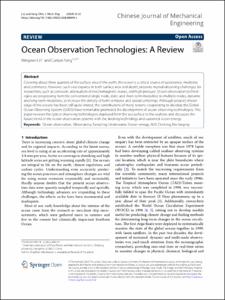Ocean Observation Technologies: A Review.

View/
Average rating
votes
Date
2020Author
Lin, Mingwei
Yang, Canjun
Metadata
Show full item recordAbstract
Covering about three quarters of the surface area of the earth, the ocean is a critical source of sustenance, medicine,
and commerce. However, such vast expanse in both surface area and depth, presents myriad observing challenges for
researchers, such as corrosion, attenuation of electromagnetic waves, and high pressure. Ocean observation technologies
are progressing from the conventional single node, static and short-term modalities to multiple nodes, dynamic
and long-term modalities, to increase the density of both temporal and spatial samplings. Although people’s knowledge
of the oceans has been still quite limited, the contributions of many nations cooperating to develop the Global
Ocean Observing System (GOOS) have remarkably promoted the development of ocean observing technologies. This
paper reviews the typical observing technologies deployed from the sea surface to the seafloor, and discusses the
future trend of the ocean observation systems with the docking technology .....
Journal
Chinese Journal of Mechanical EngineeringVolume
33Issue
Article 32Page Range
18pp.Document Language
enSustainable Development Goals (SDG)
14.aDOI Original
https://doi.org/10.1186/s10033-020-00449-zCitation
Lin, M. and Yang, C. (2020) Ocean Observation Technologies: A Review. Chinese Journal of Mechanical Engineering, 33:32, 18pp. DOI: . https://doi.org/10.1186/s10033-020-00449-zCollections
The following license files are associated with this item:
 Repository of community practices in Ocean Research, Applications and Data/Information Management
Repository of community practices in Ocean Research, Applications and Data/Information Management
